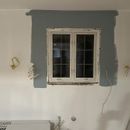Drywall penetrations
I’m currently in the middle of a kitchen/living room remodel. While we had the walls open I went through and used spray foam on all bottom and top plate penetrations and caulked the bottom plate to the exterior sheathing and subfloor. I’m hoping that will help with air sealing this 1950’s split. Now that drywall is up the drywall guys cut holes in the drywall to run the wiring for our hood vent, induction range, disposal, under cabinet lighting, etc. I’m a bit worried about the holes allowing airflow. Do you have any recommendations on how to remedy?
GBA Detail Library
A collection of one thousand construction details organized by climate and house part










Replies
If you sealed up the top and bottom plates, and any penetrations through the studs, plus the outside sheathing, then you should have a redundant air barrier formed by the exterior sheathing (assuming it's some kind of panel product with no seams in the studbays), then you should be pretty much OK here. The holes will allow for air exchange with the stud bays though, which could increase the possibility for moisture issues.
For the hood, I like to use a cable clamp installed "backwards" (the clamp part on the INSIDE of the hood), then after clamping the cable in place, I inject some canned foam to seal between the wall, cable, and back of the range. That's probably the best/easiest way to go with that one. For the others, my preference is to install all the wiring in boxes just like you would for receptacles, then use a blank cover with a knockout to make a "connection" to any hardwired appliances. This way you just airseal the electrical boxes in the usual way, and make a simple pigtail for the appliance from the cover plate, which all uses readily available materials.
Bill
Bill,
"my preference is to install all the wiring in boxes just like you would for receptacles"
Yes. I've never understood leaving loose wires in the wall or ceiling and then pulling them once the drywall in, and disrupting the insulation. I use boxes for resistance baseboard heaters too.